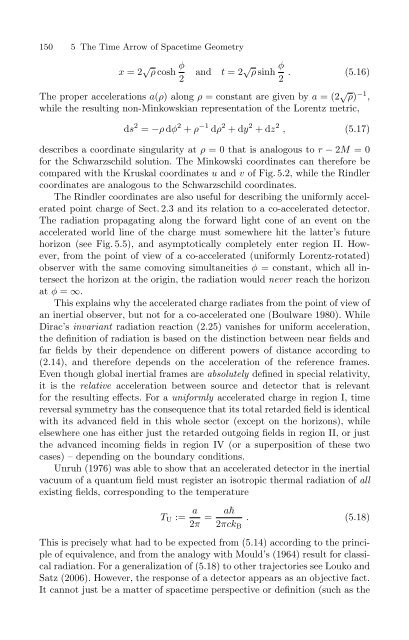The Physical Basis of The Direction of Time (The Frontiers ...
The Physical Basis of The Direction of Time (The Frontiers ...
The Physical Basis of The Direction of Time (The Frontiers ...
Create successful ePaper yourself
Turn your PDF publications into a flip-book with our unique Google optimized e-Paper software.
150 5 <strong>The</strong> <strong>Time</strong> Arrow <strong>of</strong> Spacetime Geometry<br />
x =2 √ ρ cosh φ 2<br />
and t =2 √ ρ sinh φ 2 . (5.16)<br />
<strong>The</strong> proper accelerations a(ρ) alongρ = constant are given by a =(2 √ ρ) −1 ,<br />
while the resulting non-Minkowskian representation <strong>of</strong> the Lorentz metric,<br />
ds 2 = −ρ dφ 2 + ρ −1 dρ 2 +dy 2 +dz 2 , (5.17)<br />
describes a coordinate singularity at ρ = 0 that is analogous to r − 2M =0<br />
for the Schwarzschild solution. <strong>The</strong> Minkowski coordinates can therefore be<br />
compared with the Kruskal coordinates u and v <strong>of</strong> Fig. 5.2, while the Rindler<br />
coordinates are analogous to the Schwarzschild coordinates.<br />
<strong>The</strong> Rindler coordinates are also useful for describing the uniformly accelerated<br />
point charge <strong>of</strong> Sect. 2.3 and its relation to a co-accelerated detector.<br />
<strong>The</strong> radiation propagating along the forward light cone <strong>of</strong> an event on the<br />
accelerated world line <strong>of</strong> the charge must somewhere hit the latter’s future<br />
horizon (see Fig. 5.5), and asymptotically completely enter region II. However,<br />
from the point <strong>of</strong> view <strong>of</strong> a co-accelerated (uniformly Lorentz-rotated)<br />
observer with the same comoving simultaneities φ = constant, which all intersect<br />
the horizon at the origin, the radiation would never reach the horizon<br />
at φ = ∞.<br />
This explains why the accelerated charge radiates from the point <strong>of</strong> view <strong>of</strong><br />
an inertial observer, but not for a co-accelerated one (Boulware 1980). While<br />
Dirac’s invariant radiation reaction (2.25) vanishes for uniform acceleration,<br />
the definition <strong>of</strong> radiation is based on the distinction between near fields and<br />
far fields by their dependence on different powers <strong>of</strong> distance according to<br />
(2.14), and therefore depends on the acceleration <strong>of</strong> the reference frames.<br />
Even though global inertial frames are absolutely defined in special relativity,<br />
it is the relative acceleration between source and detector that is relevant<br />
for the resulting effects. For a uniformly accelerated charge in region I, time<br />
reversal symmetry has the consequence that its total retarded field is identical<br />
with its advanced field in this whole sector (except on the horizons), while<br />
elsewhere one has either just the retarded outgoing fields in region II, or just<br />
the advanced incoming fields in region IV (or a superposition <strong>of</strong> these two<br />
cases) – depending on the boundary conditions.<br />
Unruh (1976) was able to show that an accelerated detector in the inertial<br />
vacuum <strong>of</strong> a quantum field must register an isotropic thermal radiation <strong>of</strong> all<br />
existing fields, corresponding to the temperature<br />
T U := a<br />
2π = a . (5.18)<br />
2πck B<br />
This is precisely what had to be expected from (5.14) according to the principle<br />
<strong>of</strong> equivalence, and from the analogy with Mould’s (1964) result for classical<br />
radiation. For a generalization <strong>of</strong> (5.18) to other trajectories see Louko and<br />
Satz (2006). However, the response <strong>of</strong> a detector appears as an objective fact.<br />
It cannot just be a matter <strong>of</strong> spacetime perspective or definition (such as the



![arXiv:1001.0993v1 [hep-ph] 6 Jan 2010](https://img.yumpu.com/51282177/1/190x245/arxiv10010993v1-hep-ph-6-jan-2010.jpg?quality=85)


![arXiv:1008.3907v2 [astro-ph.CO] 1 Nov 2011](https://img.yumpu.com/48909562/1/190x245/arxiv10083907v2-astro-phco-1-nov-2011.jpg?quality=85)








![arXiv:1002.4928v1 [gr-qc] 26 Feb 2010](https://img.yumpu.com/41209516/1/190x245/arxiv10024928v1-gr-qc-26-feb-2010.jpg?quality=85)
![arXiv:1206.2653v1 [astro-ph.CO] 12 Jun 2012](https://img.yumpu.com/39510078/1/190x245/arxiv12062653v1-astro-phco-12-jun-2012.jpg?quality=85)
